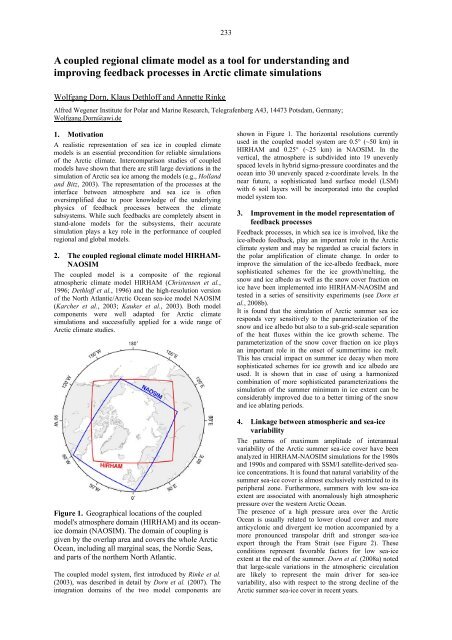Low (web) Quality - BALTEX
Low (web) Quality - BALTEX
Low (web) Quality - BALTEX
You also want an ePaper? Increase the reach of your titles
YUMPU automatically turns print PDFs into web optimized ePapers that Google loves.
233<br />
A coupled regional climate model as a tool for understanding and<br />
improving feedback processes in Arctic climate simulations<br />
Wolfgang Dorn, Klaus Dethloff and Annette Rinke<br />
Alfred Wegener Institute for Polar and Marine Research, Telegrafenberg A43, 14473 Potsdam, Germany;<br />
Wolfgang.Dorn@awi.de<br />
1. Motivation<br />
A realistic representation of sea ice in coupled climate<br />
models is an essential precondition for reliable simulations<br />
of the Arctic climate. Intercomparison studies of coupled<br />
models have shown that there are still large deviations in the<br />
simulation of Arctic sea ice among the models (e.g., Holland<br />
and Bitz, 2003). The representation of the processes at the<br />
interface between atmosphere and sea ice is often<br />
oversimplified due to poor knowledge of the underlying<br />
physics of feedback processes between the climate<br />
subsystems. While such feedbacks are completely absent in<br />
stand-alone models for the subsystems, their accurate<br />
simulation plays a key role in the performance of coupled<br />
regional and global models.<br />
2. The coupled regional climate model HIRHAM-<br />
NAOSIM<br />
The coupled model is a composite of the regional<br />
atmospheric climate model HIRHAM (Christensen et al.,<br />
1996; Dethloff et al., 1996) and the high-resolution version<br />
of the North Atlantic/Arctic Ocean sea-ice model NAOSIM<br />
(Karcher et al., 2003; Kauker et al., 2003). Both model<br />
components were well adapted for Arctic climate<br />
simulations and successfully applied for a wide range of<br />
Arctic climate studies.<br />
Figure 1. Geographical locations of the coupled<br />
model's atmosphere domain (HIRHAM) and its oceanice<br />
domain (NAOSIM). The domain of coupling is<br />
given by the overlap area and covers the whole Arctic<br />
Ocean, including all marginal seas, the Nordic Seas,<br />
and parts of the northern North Atlantic.<br />
The coupled model system, first introduced by Rinke et al.<br />
(2003), was described in detail by Dorn et al. (2007). The<br />
integration domains of the two model components are<br />
shown in Figure 1. The horizontal resolutions currently<br />
used in the coupled model system are 0.5° (~50 km) in<br />
HIRHAM and 0.25° (~25 km) in NAOSIM. In the<br />
vertical, the atmosphere is subdivided into 19 unevenly<br />
spaced levels in hybrid sigma-pressure coordinates and the<br />
ocean into 30 unevenly spaced z-coordinate levels. In the<br />
near future, a sophisticated land surface model (LSM)<br />
with 6 soil layers will be incorporated into the coupled<br />
model system too.<br />
3. Improvement in the model representation of<br />
feedback processes<br />
Feedback processes, in which sea ice is involved, like the<br />
ice-albedo feedback, play an important role in the Arctic<br />
climate system and may be regarded as crucial factors in<br />
the polar amplification of climate change. In order to<br />
improve the simulation of the ice-albedo feedback, more<br />
sophisticated schemes for the ice growth/melting, the<br />
snow and ice albedo as well as the snow cover fraction on<br />
ice have been implemented into HIRHAM-NAOSIM and<br />
tested in a series of sensitivity experiments (see Dorn et<br />
al., 2008b).<br />
It is found that the simulation of Arctic summer sea ice<br />
responds very sensitively to the parameterization of the<br />
snow and ice albedo but also to a sub-grid-scale separation<br />
of the heat fluxes within the ice growth scheme. The<br />
parameterization of the snow cover fraction on ice plays<br />
an important role in the onset of summertime ice melt.<br />
This has crucial impact on summer ice decay when more<br />
sophisticated schemes for ice growth and ice albedo are<br />
used. It is shown that in case of using a harmonized<br />
combination of more sophisticated parameterizations the<br />
simulation of the summer minimum in ice extent can be<br />
considerably improved due to a better timing of the snow<br />
and ice ablating periods.<br />
4. Linkage between atmospheric and sea-ice<br />
variability<br />
The patterns of maximum amplitude of interannual<br />
variability of the Arctic summer sea-ice cover have been<br />
analyzed in HIRHAM-NAOSIM simulations for the 1980s<br />
and 1990s and compared with SSM/I satellite-derived seaice<br />
concentrations. It is found that natural variability of the<br />
summer sea-ice cover is almost exclusively restricted to its<br />
peripheral zone. Furthermore, summers with low sea-ice<br />
extent are associated with anomalously high atmospheric<br />
pressure over the western Arctic Ocean.<br />
The presence of a high pressure area over the Arctic<br />
Ocean is usually related to lower cloud cover and more<br />
anticyclonic and divergent ice motion accompanied by a<br />
more pronounced transpolar drift and stronger sea-ice<br />
export through the Fram Strait (see Figure 2). These<br />
conditions represent favorable factors for low sea-ice<br />
extent at the end of the summer. Dorn et al. (2008a) noted<br />
that large-scale variations in the atmospheric circulation<br />
are likely to represent the main driver for sea-ice<br />
variability, also with respect to the strong decline of the<br />
Arctic summer sea-ice cover in recent years.













